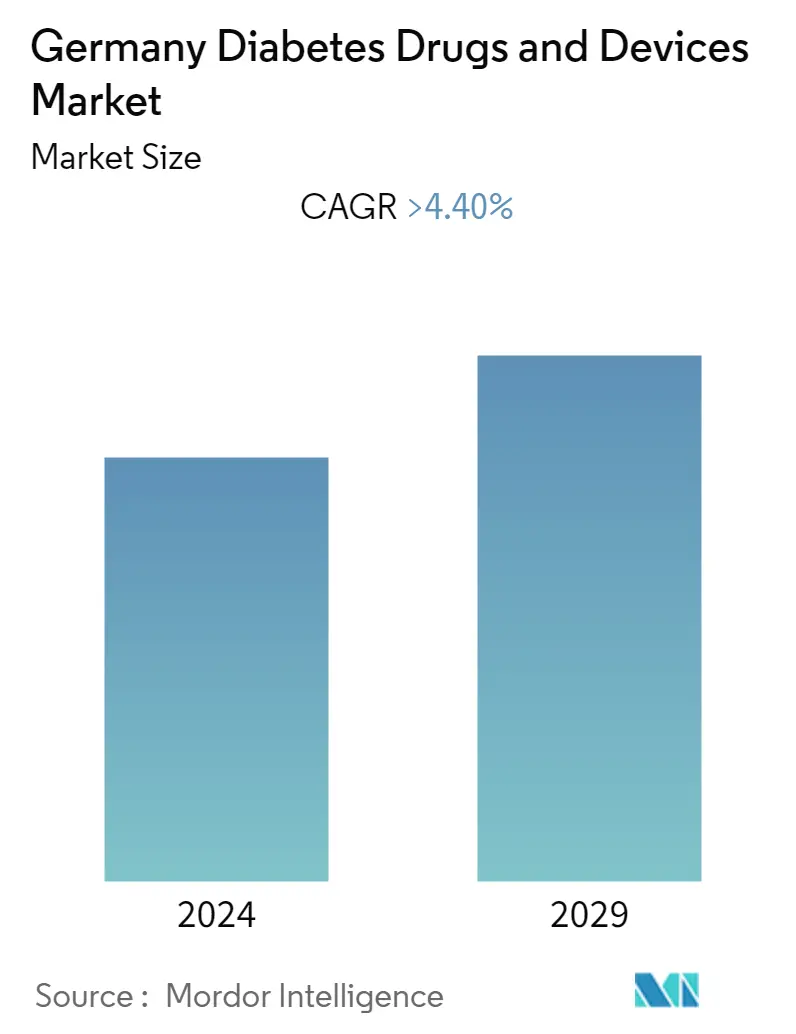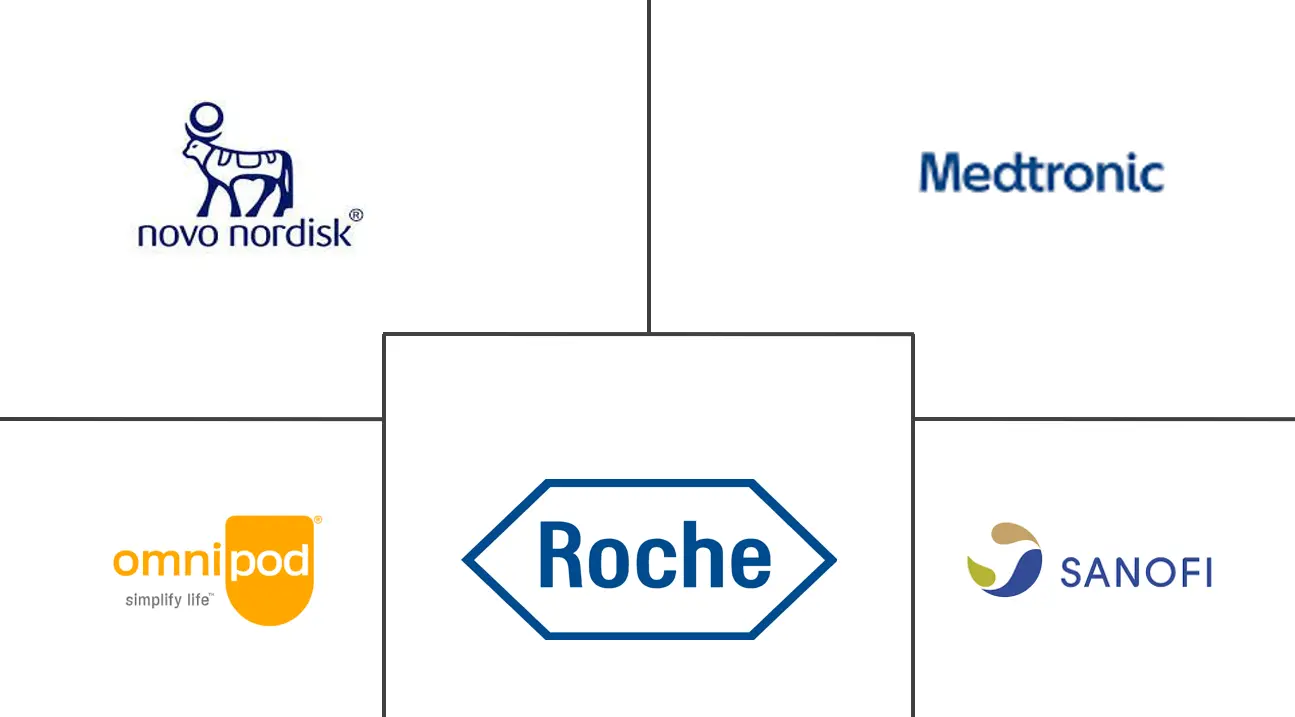Market Size of Germany Diabetes Drugs and Devices Industry

| Study Period | 2018 - 2029 |
| Base Year For Estimation | 2023 |
| Forecast Data Period | 2024 - 2029 |
| Historical Data Period | 2018 - 2022 |
| CAGR | 4.40 % |
Major Players
*Disclaimer: Major Players sorted in no particular order |
Germany Diabetes Drugs and Devices Market Analysis
Germany's diabetes drugs and devices market size is estimated at USD 6 billion in the current year. The market is expected to reach USD 7.5 billion in five years, registering a CAGR of more than 4.4% during the forecast period.
The COVID-19 pandemic has significantly impacted the diabetes care device market. The prevalence of diabetes in patients hospitalized with COVID-19 and evidence that improved glycemic control may improve outcomes and shorten hospital stays in patients with SARS-CoV-2 has led to a reduction in diabetes mellitus. The importance of therapeutic equipment is emphasized. The pandemic has also highlighted opportunities to continue and expand innovation in diabetes care through virtual consultations between healthcare providers and people with diabetes and with diabetes technology. Crisis management has led to unprecedented interest in telemedicine from patients and healthcare professionals, removing many long-standing regulatory barriers.
Diabetes drugs and devices are designed to stabilize and control blood sugar levels in people with diabetes. Antidiabetic drugs have become potential candidates for treating diabetic patients affected by SARS-CoV-2 infection during the novel coronavirus disease (COVID-19) pandemic. According to the German Diabetes Center (DDZ), at least 7.2% of the German population currently has diabetes, and the trend is expected to increase significantly over the next 20 years. It has been observed that the rate of new diagnoses of type 1 and type 2 diabetes is increasing, mainly due to obesity, unhealthy diet, and lack of exercise. Rapid increases in the incidence and prevalence of diabetes and health care costs indicate an increase in the use of antidiabetic drugs.
Germany is one of the developed countries, and when it comes to medical care, it is a developed country. Technologies such as continuous blood glucose monitoring and insulin infusion pumps have been adopted in Germany earlier than in other developing countries. Additionally, redemption and pricing policies are highly regulated, which drives the market and increases acceptance of new advanced technologies. Market opportunities for players in the German diabetes care devices market include numerous new product introductions, increased international research collaboration for technological advances, and increased public education on diabetes.
Thus, the above factors are expected to drive market growth over the forecast period.
Germany Diabetes Drugs and Devices Industry Segmentation
People with type 2 diabetes also need to take antidiabetic drugs. these drugs include diabetes medications and injections such as insulin. germany diabetes drugs and devices market is segmented by drugs (insulin, oral anti-diabetic drugs, non-insulin injectable drugs, and combination drugs), and devices (management devices (insulin pumps, insulin pens, syringes, cartridges, and jet injectors) and monitoring devices (self-monitoring blood and continuous glucose monitoring)). The report offers the value (in USD) and volume (in unit) for the above segments.
| Devices | ||||||
| ||||||
|
| Drugs | |
| Oral Anti-Diabetes Drugs | |
| Insulin Drugs | |
| Combination Drugs | |
| Non-Insulin Injectable Drugs |
Germany Diabetes Drugs and Devices Market Size Summary
The diabetes drugs and devices market in Germany is poised for significant growth, driven by an increasing prevalence of diabetes and advancements in medical technology. The market is characterized by the adoption of innovative solutions such as continuous blood glucose monitoring and insulin infusion pumps, which have been integrated into the healthcare system earlier than in many other countries. The COVID-19 pandemic has further accelerated the adoption of telemedicine and virtual consultations, highlighting the importance of diabetes care devices and creating new opportunities for market expansion. The regulatory environment in Germany, with its stringent policies and support for new technologies, facilitates the introduction of advanced diabetes care products, thereby enhancing market dynamics.
The rising incidence of diabetes, fueled by factors such as obesity, unhealthy diets, and sedentary lifestyles, has led to an increased demand for antidiabetic drugs and devices. Oral antidiabetic agents remain a popular choice due to their efficacy, safety, and cost-effectiveness, making them an attractive alternative to insulin. The market is also witnessing a surge in public education and international research collaborations, which are crucial for technological advancements and product development. Major players in the industry, including Abbott, Medtronic, and Novo Nordisk, are actively engaging in mergers, acquisitions, and partnerships to strengthen their market position. The focus on integrated and personalized chronic disease management, supported by real-world health data, is expected to drive further growth in the German diabetes market over the forecast period.
Germany Diabetes Drugs and Devices Market Size - Table of Contents
-
1. MARKET DYNAMICS
-
1.1 Market Overview
-
1.2 Market Dynamics
-
1.2.1 Market Drivers
-
1.2.2 Market Restraints
-
-
1.3 Porter's Five Forces Analysis
-
1.3.1 Bargaining Power of Suppliers
-
1.3.2 Bargaining Power of Consumers
-
1.3.3 Threat of New Entrants
-
1.3.4 Threat of Substitute Products and Services
-
1.3.5 Intensity of Competitive Rivalry
-
-
-
2. Market Segmentation (Market Size by Value - USD)
-
2.1 Devices
-
2.1.1 Monitoring Devices
-
2.1.1.1 Self-monitoring Blood Glucose Devices
-
2.1.1.2 Continuous Blood Glucose Monitoring
-
-
2.1.2 Management Devices
-
2.1.2.1 Insulin Pump
-
2.1.2.2 Insulin Syringes
-
2.1.2.3 Insulin Cartridges
-
2.1.2.4 Disposable Pens
-
-
-
2.2 Drugs
-
2.2.1 Oral Anti-Diabetes Drugs
-
2.2.2 Insulin Drugs
-
2.2.3 Combination Drugs
-
2.2.4 Non-Insulin Injectable Drugs
-
-
Germany Diabetes Drugs and Devices Market Size FAQs
What is the current undefined size?
The undefined is projected to register a CAGR of greater than 4.4% during the forecast period (2025-2030)
Who are the key players in undefined?
Medtronics, Roche, NovoNordisk, Sanofi and Omnipod are the major companies operating in the undefined.

